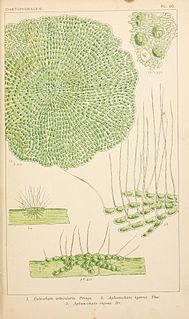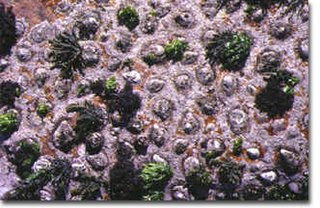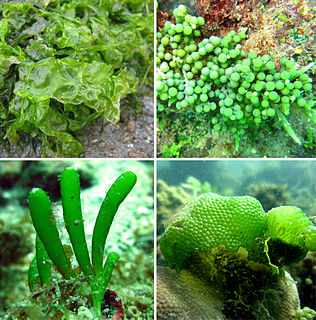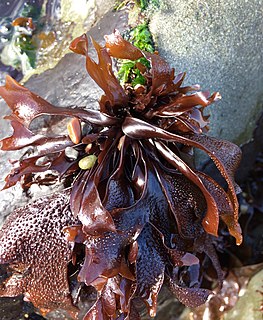
Arame, sea oak is a species of kelp, of the brown algae, best known for its use in Japanese cuisine.
Ascoseira is a monotypic genus of seaweed in the brown algae. The single and type species, Ascoseira mirabilis Skottsberg, is a large parenchymatous macroalgae, and is endemic to the Antarctic Ocean. Ascoseira is assigned to its own order. The alga grows in subtidal waters at depths of from 3 to 15 meters.

Chlorodesmis is a genus of green algae in the family Udoteaceae. Algae in this genus produce the toxic diterpene chlorodesmin to defend themselves against generalist herbivores This toxin also kills certain corals that touch the alga. Certain fish like the green coral goby that live in the corals eat the alga to enhance their own toxicity. Other coral dwelling fish like Paragobiodon echinocephalus actively trim the alga even though they don't eat it.
Pleurastrum is a genus of green algae, specifically of the Chlorophyceae. As of February 2022, it was the only genus in the family Pleurastraceae.
Genicularina is a genus of green algae, specifically of the Gonatozygaceae.
Staurodesmus is a genus of green algae, specifically of the Desmidiaceae.
Chlorokybus is a multicellular (sarcinoid) genus of basal green algae or charophyte, a soil alga. It has been classified as the sole member of the family Chlorokybaceae, which is the sole member of the order Chlorokybales, in turn the sole member of the class Chlorokybophyceae.

Coleochaetophyceae are a class of charophyte algae that includes some of the closest multicellular relatives of land plants. Their mitogenome is the most intron rich organelle among the streptophyte algae.

Scutellastra cochlear is a species of sea snail, a marine gastropod mollusc in the family Patellidae, one of the families of true limpets. It is commonly known as the snail patella, the pear limpet or the spoon limpet and is native to South Africa. It often grows in association with the crustose coralline alga Spongites yendoi and a filamentous red alga which it cultivates in a garden. It was first described by the malacologist Ignaz von Born in 1778 as Patella cochlear.
Pseudochorda is a genus of thalloid brown algae including two species.
Permocalculus is a genus of red algae known from Permian to Cretaceous strata. Closely aligned to Gymnocodium, it is placed in the Gymnocodiaceae.
Ulva ohnoi is a species of light-green coloured seaweed in the family Ulvaceae that is endemic to Japan.

Spongites yendoi is a species of crustose red seaweed with a hard, calcareous skeleton in the family Corallinaceae. It is found on the lower shore as part of a diverse community in the southeastern Atlantic Ocean and the Indo-Pacific Ocean.

Acetabularia acetabulum is a species of green alga in the family Polyphysaceae. It is found in the Mediterranean Sea at a depth of one to two metres.

Phyllophora antarctica is a species of red alga in the family Phyllophoraceae. It is native to Antarctica where it grows in dim light on the underside of sea ice. Some of it becomes detached and accumulates in drifts on the seabed. Many different organisms live attached to the fronds or among them.

The Chlorophytina are a proposed basal Tetraphytina clade. It is currently seen as sister of the Pedinomonadaceae. It contains the more well-known green alga and is characterized by the presence of phycoplasts.

Mastocarpus papillatus, sometimes called Turkish washcloth, black tar spot, or grapestone is a species of red algae in the family Phyllophoraceae. It is sometimes confused with the distantly related Turkish towel which is of a similar texture but larger. The specific epithet papillatus is due to the nipple-like projections on the female gametophyte which can give the texture of a terrycloth washcloth found at a Turkish bath.
Hypoglossum hypoglossoides, known as under tongue weed, is a small red marine alga in the family Delesseriaceae.
Osmundea hybrida is a fairly small marine red alga.
Zanardinia is a monotypic genus of seaweed in the brown algae. The only species, Zanardinia typus, commonly known as penny weed, is native to the northeastern Atlantic Ocean and the Mediterranean Sea.







